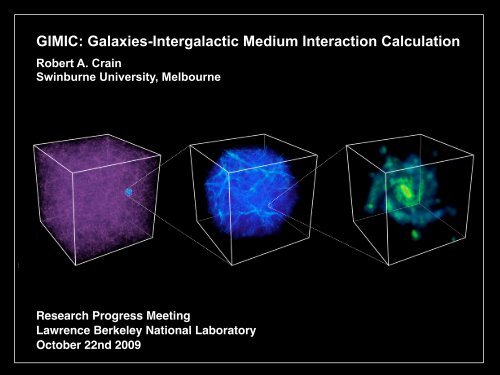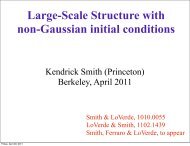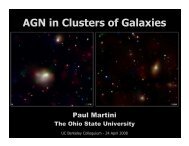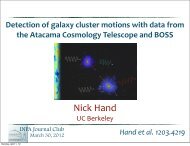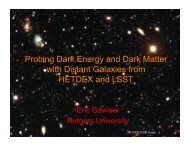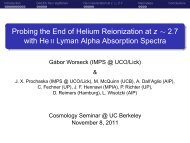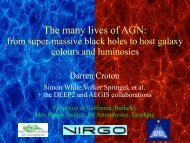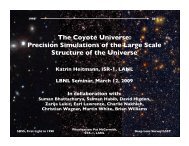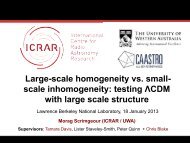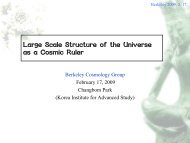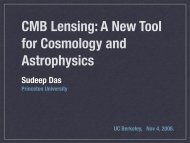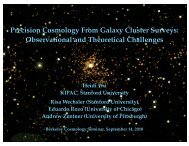GIMIC: Galaxies-Intergalactic Medium Interaction Calculation
GIMIC: Galaxies-Intergalactic Medium Interaction Calculation
GIMIC: Galaxies-Intergalactic Medium Interaction Calculation
Create successful ePaper yourself
Turn your PDF publications into a flip-book with our unique Google optimized e-Paper software.
<strong>GIMIC</strong>: <strong>Galaxies</strong>-<strong>Intergalactic</strong> <strong>Medium</strong> <strong>Interaction</strong> <strong>Calculation</strong><br />
Robert A. Crain<br />
Swinburne University, Melbourne<br />
Research Progress Meeting<br />
Lawrence Berkeley National Laboratory<br />
October 22nd 2009
Why simulate galaxy formation?<br />
Semi-analytic models proven very successful<br />
Reproduce the cosmic star formation history<br />
Reproduce the galaxy population by mass<br />
Reproduce the colour-magnitude relation<br />
....but by design adopt severe simplifications<br />
....phenomenology doesn’t play by the rules<br />
Simulating hydrodynamics more teaches us more<br />
Are (semi-)analytic simplifications appropriate?<br />
Can directly probe interaction of galaxies with<br />
intergalactic gas.<br />
Interfaces more directly with observables
The simulator’s dynamic range double whammy<br />
<strong>Galaxies</strong> are much bigger than stars and black holes<br />
Individual supernovae and active galactic<br />
nuclei impart galaxy-wide effects<br />
Recourse to phenomenology, on some scale,<br />
is inevitable.<br />
<strong>Galaxies</strong> are much smaller than the large-scale structure<br />
Surveys trace LSS using millions of galaxies<br />
<strong>Galaxies</strong> pollute intergalactic gas with heavy<br />
elements on ~Mpc scales<br />
To compete with semi-analytics<br />
Trace volumes of L > 100 Mpc<br />
Use resolution of m_gas < 10^7 Msun<br />
Lawrence Berkeley National Laboratory<br />
October 22nd 2009
Rosette nebula<br />
In Monoceros molecular cloud<br />
10pc
M31<br />
100kpc
Millennium Simulation<br />
Volume comparable to SDSS at median redshift z~0.1<br />
500Mpc
<strong>GIMIC</strong>: A novel approach<br />
Aim: trace coevolution of galaxies and IGM in a<br />
cosmological context<br />
Follow hundreds of galaxies<br />
Large volumes of the IGM<br />
Varied cosmological environments<br />
“Simulation in a simulation”<br />
Method: adopt ‘zoomed’ initial conditions<br />
Take large parent dark matter volume at z=0<br />
Trace back regions of interest to early times<br />
Resample density field with multi-resolution<br />
scheme, adding small scale power.<br />
Add gas to high-resolution region and re-run<br />
October 22nd 2009
Millennium Volume<br />
L = 500 Mpc/h<br />
Six orders of magnitude in length scale<br />
<strong>GIMIC</strong> hi-res region (1 of 5)<br />
L ~ 50 Mpc/h<br />
<strong>GIMIC</strong> galaxy (1 of ~1000)<br />
force resolution ~500pc
<strong>GIMIC</strong>: the simulation code<br />
Gadget-3<br />
Domain decomposition optimised for highdynamic<br />
range problems (also: Aquarius)<br />
New physics modules: cooling, SF, kinetic feedback<br />
(also: Overwhelmingly Large Simulations, OWLS)<br />
Key features<br />
High-density gas (interstellar medium) is single phase<br />
Apply equation of state, P = k.rho^gamma to<br />
yield ISM effective pressure<br />
Star formation based on density, parametrised by<br />
observables<br />
Supernova-driven winds triggered locally and not<br />
decoupled from hydrodynamical forces<br />
Gas cooling rate considers 11 heavy elements<br />
and UV background
October 22nd 2009<br />
The dark matter halo population
October 22nd 2009<br />
The galaxy population, by stellar mass
October 22nd 2009<br />
The galaxy population, by stellar mass
October 22nd 2009<br />
The star formation rate density
The star formation rate density (mass normalised)<br />
October 22nd 2009
The star formation rate density is hierarchical<br />
October 22nd 2009
SFRD<br />
Durham semi-analytic model - broken hierarchy<br />
Massive<br />
Bower+ ’06, with AGN<br />
Regular<br />
Redshift<br />
Dwarf galaxies always dominate<br />
Massive galaxies become<br />
passive quickly<br />
Total<br />
Dwarf<br />
SFRD<br />
Total<br />
Massive<br />
Regular<br />
Redshift<br />
Bower+ ’06, AGN ‘off’<br />
Dwarf<br />
Massive galaxies dominate z
Bower+ ‘06<br />
Regular<br />
Dwarf<br />
Massive<br />
Redshift<br />
An aside on downsizing<br />
Passive<br />
Active<br />
Ratio past average : present star formation rate<br />
value > 1, past SFR dominates: passive<br />
value < 1, present SFR dominates: active<br />
Massive galaxies become passive earliest<br />
<strong>GIMIC</strong>, Crain+ ’09<br />
Massive<br />
Regular<br />
Dwarf<br />
Passive<br />
Active<br />
Similar behaviour in <strong>GIMIC</strong>, w/out AGN<br />
Massive galaxies passive before dwarfs<br />
Just not as passive as with AGN<br />
AGN exacerbate (not cause of) shutdown
Crain+ ’07, no cooling, SF or feedback<br />
Fraction of cosmic share accreted<br />
(Dwarfs) Halo mass (Clusters)<br />
In non-radiative regime, the haloes accrete<br />
~90% of their cosmic share of baryons<br />
small losses due to assembly shocks<br />
self-similar process, no preferred scale<br />
Scales come from non-gravitational physics<br />
Baryons (gas, stars) in haloes<br />
Fraction of cosmic share accreted<br />
Crain+ ’09, <strong>GIMIC</strong> physics<br />
90% locus<br />
Ejection<br />
Warm<br />
ISM<br />
Stars<br />
Hot<br />
(Dwarfs) Halo mass (Clusters)<br />
Arrow shows halo ‘velocity’ of 600km/s<br />
Below this scale baryons are ejected<br />
Balance of heating & cooling establishes<br />
complex thermal structure: tough to observe!
Halo star formation efficiency - SFR per unit total mass
Halo mass is king - yet environment still matters<br />
Environmentally<br />
varying halo<br />
mass function<br />
Environmentally<br />
invariant halo<br />
SF efficiency<br />
Star formation<br />
rate density
Case study of hydro benefits: the X-ray halo problem<br />
Analytic galaxy formation models in CDM:<br />
Disc galaxies are common, but fragile<br />
‘Easy come, easy go’ - must still be<br />
forming today<br />
Fuelling by cooling flow from hydrostatic<br />
halo gas at virial temperature of 10^6K<br />
No detections with ROSAT (e.g. Benson+ ’00)<br />
Handful of XMM, Chandra detections, inferred<br />
luminosities 1-2dex below predictions<br />
Cited as a problem for CDM<br />
Cooling should be in soft X-ray band,<br />
at fluxes readily detected by ROSAT<br />
Might it be that model assumptions<br />
merely inaccurate? Can test with<br />
hydro.
Acid test: Lx - Lk relation
Bottom line: SF and ejection alter hot gas radial profile<br />
x10
Summary<br />
Novel techniques required to keep pace with observations<br />
Use of ‘zoomed initial conditions’, or ‘simulations within<br />
simulations’ enables well-resolved galaxies to be studied<br />
within a cosmological context<br />
Halo mass is key driver of star formation history<br />
The volume-normalised star formation rate differs on<br />
multi-Mpc scales by up to ~x10. Driven by halo mass<br />
function rather than an environmental effect on galaxies.<br />
The importance of black holes to the cosmic star<br />
formation history remains an open, and critical, issue.<br />
Hydro highlights weaknesses in analytic prescriptions<br />
Gas treatments in (semi-)analytic models can be oversimplified,<br />
leading to a mis-interpretation of<br />
Lawrence<br />
observational<br />
Berkeley<br />
findings,<br />
National<br />
e.g.<br />
Laboratory<br />
X-ray halo problem.<br />
October 22nd 2009


